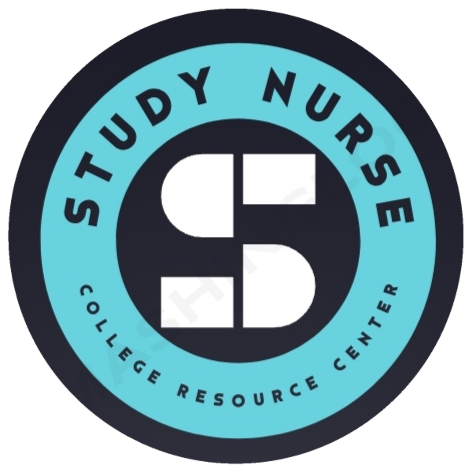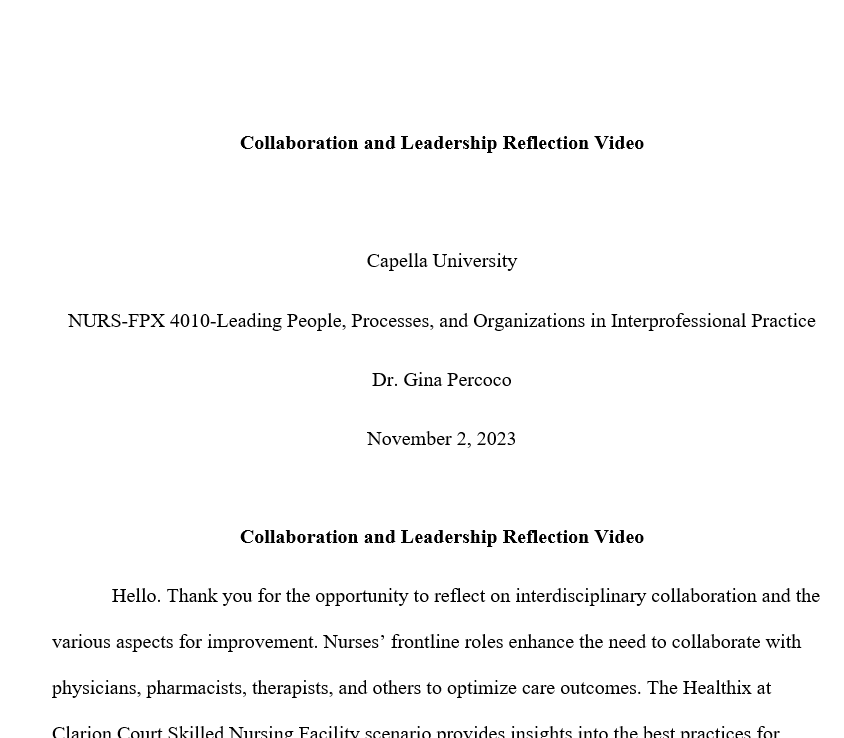Interdisciplinary Plan Proposal
Capella University
NURS-FPX 4010-Leading People, Processes, and Organizations in Interprofessional Practice
Dr. Eunice Rosas
August 19, 2023
Interdisciplinary Plan Proposal
Improving patient outcomes and attaining strategic goals are vital considerations for nurses. Nurse leaders should encourage participants to create a shared vision and team goals. The goal is to offer opportunities to share experiences, knowledge, and skills within and outside the health care environment. The interdisciplinary plan addressed in this assessment includes nurses, physicians, the nurse manager, and pharmacists. The group plays a significant role in optimizing medication administration to achieve the intended quality and safety of patient care. Adopting the Plan-Do-Study-Act (PDSA) model guides the team to share accurate and complete information on efforts to reduce medication errors.
Objectives and Predictions
- To engage the team on wrong medication administration trends and risk factors. The prediction is that different care team members will embrace shared interdisciplinary governance to reinforce the collective commitment to enhancing vigilance across the care continuum (Manias, 2018). The process will promote timely reporting and interception of medication errors.
- To design and implement comprehensive educational sessions reinforcing the need for collective commitment to reducing medication administration errors. The prediction is that different care team members will participate in briefings and educational sessions (Tsegaye et al., 2020). The workforce will demonstrate open and honest sharing of details on risk factors associated with wrong medication administration.
- To prevent nurses from overriding safeguards adopted to reduce the risk of wrong medication administration. The prediction is that the nursing team will remain responsive to policies, standards, and procedures on medication verification and administration (Tsegaye et al., 2020). The process enhances responsibility and accountability during medication administration.
Change Theories and Leadership Interventions
Successful outcomes depend on effective leadership and change management. The PDSA cycle provides a systematic framework for encouraging everyone to understand the principles of improvement and facilitate meaningful changes in the acute care setting. The goal is to ensure that everyone engages positively with change (Crowfoot & Prasad, 2017). First, the team will familiarize themselves with wrong drug administration and adverse impacts on the organization. The PDSA cycle also encourages leaders to share a common vision and details of the beliefs, values, and behaviors that enhance interdisciplinary practices (McGowan & Reid, 2018). The nurse manager explains the need for a comprehensive education to familiarize everyone with a personal and professional commitment to optimizing quality and safety outcomes. The second phase is sharing educational materials such as rounding checklists and watching videos on medication administration practices.
The interdisciplinary process will also involve the leader engaging the team on outcomes, barriers, and enablers that produce the intended results. The nurse leader will outline the progress and alignment with the stated objectives. Transformational leaders motivate different healthcare professionals to do more than is typically expected of them (Kim et al., 2020). Adopting positive attitudes and beliefs is among the influences triggered by leaders who strive to strengthen the workforce’s knowledge and participation in safety. Further, buy-in depends on the leader’s ability to share a vision, personality, and management style that enhances individual and collective mindfulness regarding the medication process and patient safety (Kim et al., 2020). Thus, the care team’s ability and motivation depend on leaders’ explanation of the benefits of interventions adopted to enhance patient safety.
Collaboration Strategy
The team includes the nurse manager, physicians, nurses, pharmacists, and an administrator. The group plays a critical role in the medication administration process. Thus, collective efforts reinforce the commitment to verifying drugs and instructions before administering them to a patient. The nurse manager will set the direction for the rest due to knowledge and experiences in frontline issues such as adverse outcomes triggered by wrong drug administration. However, open and honest conversations are necessary to overcome hierarchical barriers.
The goal is to create the right environment that encourages everyone to share details of the wrong drug administration and sustainable interventions. An incident in Vanderbilt University Medical Center in December 2017 provides insights into the relevance of interdisciplinary practices in reducing medication administration errors (Loller, 2019). A fatal drug-swap error led to the administration of vecuronium injected instead of versed. The hospital initiated reforms, including training and education on interdisciplinary collaboration, to prevent nurses from overriding safeguards adopted to enhance the quality and safety of patient care.
Resources
Successful outcomes depend on the adequacy of human, technical, and administrative resources. The briefings require a laptop, projector, handouts, and case scenarios detailing wrong medication administration, risks, frequency, implications, and solutions. A consultant is also necessary to bring a broader perspective on barriers and enablers of safe drug administration. The briefings are two and a half hours, allowing the audience to share insights into medication errors and viable solutions. Dorn VA Medical Center in South Carolina is among the hospitals previously affected by lawsuits involving wrong medication administration. In 2017, nurses at the facility administered doses of pegfilgrastim instead of filgrastim (Estes, 2017). The patient died after developing pulmonary toxicity that caused severe lung injury. The events led to changes, including staffing briefings and training to make the care team aware of policies, procedures, and standards for sustaining proper medication administration.
Table 1
Resources
| Resource | Description | Cost ($) |
| Internet connectivity | The briefings will include audio and video presentations that require a strong Internet connection. | 100 |
| Drug administration safety checklists | The audience will familiarize themselves with several risks, consequences, and solutions for wrong drug administration. | 100 |
| Medication safety pocket handouts | The audience can utilize the pocket handouts to read insights about safe medication administration across the care continuum. | 100 |
| Consultant | Offer an in-depth perspective of medication administration errors and the impact of interdisciplinary collaboration in intercepting errors. | 1,000 |
| Case scenarios | Review scenarios of organizations that initiated briefings and managed to reduce medication administration errors. | 200 |
| TOTAL | 1,500 |
References
Clausen, C., Emed, J., Frunchak, V., Purden, M., & Sol Bruno, F. (2019). Toward resilient nurse leaders: The leadership-in-action program in nursing (LEAP-IN). Nursing Leadership, 32(3), 40-56. https://pubmed.ncbi.nlm.nih.gov/31714206/
Crowfoot, D., & Prasad, V. (2017). Using the Plan-Do-Study-Act (PSDA) cycle to make change in general practice. InnovAIT, 10(7), 425-430. https://journals.sagepub.com/doi/abs/10.1177/1755738017704472
Estes, A. (2017, September 16). VA hospitals flooded with complaints about care. The Boston Globe. https://www.bostonglobe.com/metro/2017/09/16/staff-veterans-hospitals-lead-federal-government-criticizing-their-employer-far/gHc8SYqcVze3tk2Xn8YAeI/story.html
Kim, M. S., Seok, J. H., Kim, B. M. (2020). Mediating role of the perceived benefits of using a medication safety system in the relationship between transformational leadership and the medication-error management climate. Journal of Research in Nursing, 25(1), 22-34. https://journals.sagepub.com/doi/pdf/10.1177/1744987118824621
Loller, T. (2019, February 20). Nurse charged in fatal drug-swap error pleads not guilty. The Associated Press. https://apnews.com/article/health-tennessee-us-news-nashville-homicide-bbc0c863fba146658786e4b91cb5dbc4
Manias, E. (2018). Effects of interdisciplinary collaboration in hospitals on medication errors: An integrative review. Expert Opinion on Drug Safety, 17(3), 259-275. https://pubmed.ncbi.nlm.nih.gov/29303376/
McGowan, M., & Reid, B. (2018). Using the Plan, Do, Study, Act cycle to enhance a patient feedback system for older adults. British Journal of Nursing, 27(16), 936–941. https://pubmed.ncbi.nlm.nih.gov/30187794/
Tsegaye, D., Alem, G., Tessema, Z., & Alebachew, W. (2020). Medication administration errors and associated factors among nurses. International Journal of General Medicine, 13, 1621-1632. https://www.ncbi.nlm.nih.gov/pmc/articles/PMC7764714/

